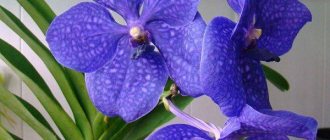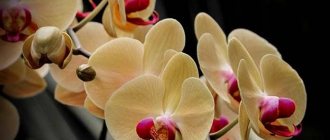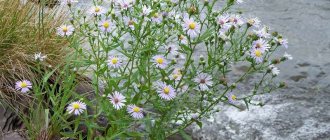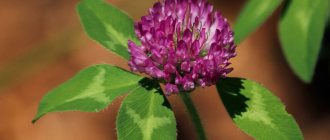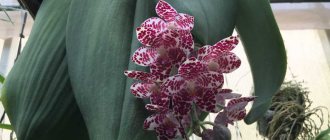In this article we will consider a description of the phalaenopsis varieties Limelight, Legato, Legend, Lady Marmalade and general recommendations for caring for them. In the meantime, a little introduction...
So you have phalaenopsis (lat. Phalaenopsis ) . It doesn't matter how anymore. And you start studying it:
- Subspecies of orchids. Belongs to epiphytes . Originally from Southeast Asia, Philippines. And northern Australia. But representatives of Japan and China claim that they have grown very successfully in their territories since ancient times;
- These are places with sufficient moisture. Forest areas of plains and mountains;
- And their popularity is higher not in the places where they grow. And in places where there is more money. And this is already a very solid business.
It’s not for nothing that entire Conventions are already being adopted. To ensure that trade in wild animals and plants does not pose a threat to their survival .
Some species can already be recognized from their descriptions. They, like mammoths, simply no longer exist. The story of Schiller's Phalaenopsis is indicative. The history of their appearance is connected with famous travelers - botanists:
- The German Georg Rumpfius discovered the first representatives in the Moluccas;
- Swedish pastor Peter Osbeck . In 1752, not so far from the island of Ternate, I also found similar specimens. But he went further. The herbarium sent to Carla Linnaeus . Who described it as delightful epidendrum ;
- Many people know Karl Blume found them After all, the current name comes from that history. He was looking for moths in the evening. And I found numerous light flowers. Like butterflies. So he called the plant similar to a butterfly (moth);
- In Greek, phalania means “night butterfly” and opsis means “resemblance.” But other names are also known;
- But back in 1678, the merchant Jacob Brain, in his book “Exotic Plants,” said that many see bees, butterflies, and spiders in them. Even toads and monkeys. The merchant was also an amateur botanist.
What the plant itself looks like:
- Leaves on a very short stem. There are 4-7 of them. Length – from 4-5 to 30 cm. Normal color – dark green. Some species have a marbled color. Light green;
- From the axils of these leaves grow peduncles and aerial roots;
- Peduncles are long. Usually 2-3. And on some even more. Many flower stalks branch;
- And, the main asset is flowers . Very varied coloring. Simply unimaginable. There can be 2-3 of them on one plant. Most often 15-20. But there are also under 100;
- Aerial roots . Unusual for flowers. Greenish and covered with velamen. Even slightly flattened.
And this drawing is for a better understanding of our conversation.
The structure of an orchid.
The structure of an orchid flower.
Prevention of diseases and pests
Infectious diseases rarely affect Phalaenopsis pelorica.
They usually suffer from improper care. Direct sunlight can cause leaf scorch if the plant is placed on a windowsill on the south side of the house. Orchids often suffer from excessive watering, the roots of the plant rot, and the green part dries out. Lack of lighting and keeping them in a cold room can also cause disease and death of the plant. A dense arrangement of orchids is not recommended; free air circulation is necessary for each plant. Periodically you need to ventilate the room, avoid allowing moisture to get on the buds when spraying. Irrigation of leaves is carried out in the first half of the day.
Sometimes pests are found on a plant sold in a store. In this case, the root system is completely separated from the soil in which the flower was sold. The plant is placed under water at room temperature and the roots are thoroughly washed.
Pelorics require high humidity in the room, but this can be easily achieved by placing a tray filled with damp pebbles or expanded clay next to the orchid. Creating comfortable conditions for keeping an orchid will protect the plant from various diseases.
Legend
The Legend variety has a low peduncle, very beautiful light petals with a purple pattern reminiscent of splashes of paint. The surface is rough, the lip is saffron-orange.
In order for an orchid to bloom for a long time, it is necessary to follow a certain regime. The optimal temperature for this plant is from +22 to +24 degrees.
The variety responds positively to increased air humidity. You need to spray the flower carefully so that the water, having collected in drops, does not flow into the outlet.
To plant phalaenopsis, a soil substrate is not required. Some gardeners successfully grow hybrids in water.
Phalaenopsis variegated
A huge number of varieties and species of orchids suggest the same diversity in the shape, size and color of Phalaenopsis leaf blades. As a rule, standard hybrids have rather large, green, matte leaves. But increasingly, not only silver, light green and dark purple, shiny like silk, or waxy-matte leaves are found, but also variegated ones.
One of the variegated Phalaenopsis is Phalaenopsis Philippinensis.
Moreover, sometimes this is a natural color, and in other cases, variegated leaves appear as a result of mutation, when there is no chlorophyll in some areas of the leaf blade. For example, on the green leaves of Phalaenopsis there is a wide yellow stripe running down the center, or a light border runs along the edge of its leaves. Such variegated leaves are found in some clones of Phalaenopsis amabilis, Phalaenopsis aphrodite, as well as Phalaenopsis Matou Freed “M”, miniature Doritaenopsis Sogo Yenlin “Variegated Leaves”, Phalaenopsis Sogo Vivien “Variegated”.
Obstinate beauties - orchids
A small part of my collection is occupied by orchids. Moreover, this direction began to actively grow only last year. Previously, I was sure that orchids are capricious, complex and delicate. There were only two such girls in my house - one was given to me, and the second to my mother. I didn’t have any special love for them, because after they bloomed, there were branched leaves and green flower stalks sticking out, which did not want to turn yellow and die. I didn’t like the spectacle at all.
But at the beginning of last year I discovered a world of variations and colors, varieties and types. It turned out that in our stores they sell such banality, but the world of orchids is much more diverse and wider! You might have come across pages of girls or shops on social networks that bring orchids from Holland. This is a very common occurrence in Ukraine; many such sellers have appeared. And their choice is much more interesting than in our florists and supermarkets.
Care
Phalaenopsis watered with warm water
For good adaptation of the plant after planting, it is necessary to properly care for it: water, feed, prune, stimulate the flowering process.
Watering
Phalaenopsis is watered with moderately warm, settled or filtered water, the temperature of which is 2-3°C above room temperature.
It is advisable to water in the first half of the day, 1-2 times a week. In dry climates it should be more regular.
Methods:
- immersion in water for 15-30 minutes;
- pour under a running shower for 15-20 minutes;
- watering from above.
Water the flowers abundantly, but at the same time carefully ensure that the substrate has time to dry completely beforehand and the roots have a silvery tint. Overmoistening can lead to rotting, and lack of moisture can lead to inhibition of shoot and root growth, leaf lethargy, and thinning of roots.
Feeding
Orchids cannot be fertilized:
- within 2 months after purchase;
- during flowering, as this can speed up the flowering of phalaenopsis;
- within a month after transplantation, when the flower is stressed.
Orchids are fertilized in a state of active growth, when roots and leaves grow, and new buds form.
It is better to use special complexes “for orchids”: Agricola, Bona Forte, Kemira-Lux, Uniflor-bud, Uniflor-rost, Greenworld, Pocon, etc. Plants react very well to succinic acid.
Fertilizer application frequency:
- in summer - 2 times a month;
- in winter - once a month.
How to grow at home
Having decided to grow the Legato butterfly orchid at home, you need to carefully analyze the characteristics of this plant, study the requirements for the conditions created and methods of care.
Selecting a room
For comfortable development, phalaenopsis needs to be provided with good lighting for 11-12 hours. In the absence of sufficient sunlight during the winter growth period, fluorescent lamps are installed.
To avoid burns, you will need protection from direct sunlight. The temperature in summer must be maintained between 24-30 degrees. In the winter season, these figures should be lower (approximately 17-25 degrees). Fresh air is required, but the plant should not be in a draft.
Watering
Water the Legato orchid with settled water every 4-5 days in the summer season. In winter, less frequent watering is required - about once a week.
It is important to prevent drops from getting inside the leaf rosette on the growing point, so the immersion method is often used. Having lifted the pot from a basin of water, wait until the excess liquid drains in order to prevent waterlogging, which is dangerous for the roots and causes rotting.
Top dressing
To maintain the necessary nutritional value of the substrate, it is advisable to purchase a special mineral complex aimed at orchid crops.
This type of fertilizer contains a balanced content of all necessary microelements, which ensures good plant development. The interval between feedings is on average 30 days.
Transfer
After acquisition, the plant must be transplanted into fresh substrate. Purchase a variety of mixture aimed at growing orchids.
Also in the spring, as growth progresses, planned Legato transplants are carried out. After watering, carefully remove the plant, clean the roots from old soil, cut off rotten shoots, and remove yellow leaves. All sections are treated with an antiseptic solution.
Expanded clay drainage is placed in a new pot, slightly larger in size than the previous container. A plant is placed in the center and covered with loose substrate, providing the roots with access to oxygen.
Protection from diseases and pests
The greatest danger to the Legato orchid is the appearance of rot, as well as the development of a fungal infection. Treatment with solutions of copper-containing preparations helps to get rid of it.
Of the harmful insects that can damage a plant, the most common are mealybugs or citrus bugs. It is important to inspect your orchid regularly. At the first signs of the appearance of parasites, prepare a solution from a tablespoon of grated laundry soap and 200 ml of warm water. Gently wipe the leaves with the product.
Phalaenopsis Orchid Butterfly
Phalaenopsis belongs to the orchid family. The plant has a short stem with wide, leathery, dark green leaves.
Butterfly orchid is the interpreted name for the common phalaenopsis.
The roots of a healthy plant are thick, elastic, covered with a layer of white coating - velamen, which allows them to absorb moisture from the air. Unlike most land plants, orchid roots contain chlorophyll, which is why they turn green when exposed to light.
Phalaenopsis flowers sit in the axils on long branched peduncles. Thanks to large side petals and a small core compared to other orchids, the phalaenopsis flower vaguely resembles a butterfly.
The Legend of the White Orchid
According to the legend of the white orchid, in South America, the young man Juan received a task from the emperor. He, according to the order, had to find an orchid of an unusual color. They wanted to decorate the palace with it. A few weeks later I reached the village. His condition was serious: Juan was tormented by a fever and was delirious. The search was unsuccessful. The young man was sheltered in a small church, where he was treated.
Over time, the young man came to his senses and, to his surprise, saw that a beautiful white orchid was rising on the roof of the temple. When the young man asked him to give him the flower, the priest refused, because for the people the plant had a symbolic meaning. During the years of famine, which resulted from drought, the faith of Christians weakened. They began to turn to pagan gods. The priest tried to bring people back to the church. To do this, he promised that the rains would pass after the villagers gave the most valuable thing to them to the temple. Then the people brought a magnificent orchid, which was on the altar used for pagan rites. Immediately after this it started to rain. After its completion, the flower’s petals turned white - the water washed away all the shades from them.
White orchid
Some varieties and varieties
Black butterfly
The darkest phalaenopsis.
The black butterfly is rightfully one of the most unusual phalaenopsis; its color will not leave gardeners unimpressed! Pictured is Black Triple Phalaenopsis.
A thick dark burgundy color with a chocolate tint that appears black in certain lighting.
The lip is white-yellow with a burgundy edging. Peduncles branch well, one has up to 8 flowers with a diameter of 5 cm.
Diamond King
A bright burgundy flower with a white edge; the lower sepals are white on the inside with small burgundy speckles. The lip is dark burgundy, the flower size is 8 cm.
Diamond King.
Manhattan
Pink flower with small burgundy specks. The core is orange. The flower is 8 cm, there are up to 10 flowers on the peduncle.
Manhattan.
The flower is crimson, almost monochromatic, 8 cm in diameter.
Pavarotti.
Valencia
A snow-white flower with a bright orange-burgundy center.
Sometimes the lower sepals are slightly yellowish. Flower diameter 7 – 8 cm.
Phalaenopsis Valencia.
Kimono
Burgundy with white and yellow border. The veins are colored darker, which is why the flower has a striped color. The center is raspberry-yellow. Flower size 7 cm.
Stunning Phalaenopsis Kimono flowers.
Delicate pink with dark specks closer to the center and a bright orange center. Diameter 8 cm.
Legato.
Peloric
Peloric is not a separate variety of orchid. This is the name given to plants with a flower shape that is non-standard for this genus, resulting from a mutation.
In phalaenopsis peloricus, the petals most often do not fully open, which is why it becomes shaped like a daffodil. But there are other forms of pelorics.
Legato Peloric.
Another burgundy Peloric.
Phalaenopsis varieties
There are hundreds of varieties of phalaenopsis, some of which are so rare and expensive that they cost a fortune. For example, Phalaenopsis Sander, which simultaneously produces up to 50 flowers on a long stem. Hybrids are the easiest to care for, so they are best suited for beginners.
Phalaenopsis Pink . A miniature type of orchid with small, up to 3 cm in diameter, white or pink flowers. Peduncle – maximum 30 cm in height. Flowers - about 15 pieces. The dark green leaves have a reddish tint on the underside. They are about 15 cm long. One of the most popular varieties among Russians.
Stewart's Phalaenopsis . Its leaves are variegated and its roots are silvery. The peduncle is long and branched (up to 80 cm), but there are a lot of flowers on it - sometimes up to 60 at a time. Delicate white flowers with red spots at the base; in the center of the flower there is an amber lip, gradually turning into purple.
Phalaenopsis Schiller . Its leaves are beautiful, variegated - silver spots on a dark green background, the lower part of the leaf is red. The inflorescences are up to 50 cm, and a simply gigantic number of small (up to 7 cm in diameter) flowers are formed on it. In the right conditions, this orchid blooms in a beautiful, unique cascade.
Phalaenopsis Philadelphia . This is a hybrid of two species - Schiller and Stewart. It has a marbled pattern on silvery leaves and small purple-pink flowers.
Phalaenopsis is nice . White large flowers up to 10 cm in diameter, about 20 flowers develop on a peduncle. The leaves are fleshy and oblong. They form a rosette of 3-5 sheets. Flowers bloom one by one, organizing themselves into flowering phases.
Phalaenopsis Cleopatra . This easy-to-care hybrid has yellow flowers dotted with small burgundy spots. There may be several flower stalks. The flowers are approximately 5-7 centimeters in diameter.
Phalaenopsis Golden . A hybrid with dark green fleshy leaves and beautiful bright yellow flowers.
Phalaenopsis Legato is also a popular hybrid with flowers painted in amazing colors of gold, pink, lilac with pearlescent iridescence.
As a rule, phalaenopsis hybrids are inexpensive, while varieties are much more expensive. Now collectors and fans of orchids have begun the hunt for pelorics - mutant orchids that bloom with unusual flowers every time.
The best time to buy phalaenopsis is during flowering. Yes, sellers usually don’t display orchids without flowers in their windows, because they look unpretentious.
- The leaves should be a healthy color, without dried out tips, fleshy, with a waxy sheen;
- the aerial roots are healthy, powerful, without signs of dryness, not rotten. They sit tightly in the substrate. If you move it slightly, they do not hang sluggishly, but hold tightly to the substrate;
- the flowers are tightly held on the peduncle, with a bright color, without signs of disease.
Home care
In order for the Wild Cat to please the owner with its flowering, it is necessary to adhere to the basic maintenance recommendations:
- The place should be well lit, preferably with diffused sunlight. If necessary, the plant should be shaded.
- It is recommended to purchase a special substrate, which will contain pine bark, peat and moss. A glass or plastic container is suitable, allowing you to monitor the degree of humidity.
- In summer +25...+30 degrees is considered normal temperature, in winter – +20 degrees. Humidity required is 40–60%. It is not recommended to allow sudden temperature changes, low humidity and drafts.
- Watering is carried out as necessary, at least 2 times a week in summer, less often in winter. It is also recommended to periodically feed with special fertilizers during the growth period along with watering. Spraying is not recommended.
- Transplantation is carried out as needed (approximately once every 2 years). It is recommended to carefully remove the flower from the pot, inspect it, remove damaged parts and place it in a new container without watering it for several days.
- You can propagate in several ways. The first is for children. The children that appear on the peduncle must grow (roots up to 5 cm), and then they are carefully separated and planted separately. The second is by dividing the peduncle. After flowering, if there are buds on the peduncle, it is cut off and divided into parts (at least one bud per part) and placed in greenhouse conditions for rooting. The third is by division. A well-developed rosette is divided into parts, leaving 2-3 leaves on each, and planted in separate containers.
- Common diseases - gray mold and fusarium - are fought with fungicides, and thrips insects - with insecticides.
Watering and fertilizing
It is when growing the phalaenopsis pelorica orchid that watering is of great importance. Most varieties of this plant love moisture, but here you should not be too zealous and flood the flower. You need to focus on the drying of the soil and the color of the roots.
With normal humidity in the apartment, the soil usually dries out on the 3-4th day. The roots take on a silver-gray tint. This means that the flower already needs watering. The dry climate in the apartment negatively affects the leaves of the peloric orchid. In this case, it is necessary to spray the leaves of the flower, but make sure that water does not get on the buds.
It is recommended to fertilize once a month; in winter it is reduced to once. They use special complex fertilizers, which can be purchased at flower shops.
Description of the orchid
The flower got its name because of its striking resemblance during the flowering period to a flock of butterflies. Phalaenopsis (translated from Greek phalani - moth, opsis - likeness).
The orchid is characterized by a monopodial growth form, that is, it has a single growth point.
In a normal flower growing without any pathologies, the shoot simultaneously has 4-6 fleshy, shiny dark green leaves. They grow alternately, with the upper ones being larger than the lower ones.
There are 4 standards:
- Mini orchids. The height of the plant together with the peduncle does not exceed 20 cm, the length of the leaf does not exceed 10 cm, the diameter of the flowers is 2-4 cm (examples: Hummingbird, Pink Girl and Philadelphia);
- Midi. Grows up to 40-55 cm, leaves up to 20 cm, flower diameter 4-7 cm (examples: Jena, Amabilis, Hieroglyphic);
- Ordinary. Reaches from 60 to 75 cm in height, leaves about 30 cm, flowers - 7-9 cm (examples: Stellenbosch and Cleopatra);
- Royal orchids - reach 80 cm, and some even one meter, leaves more than 30 cm, flowers - 12-15 cm in diameter (examples: Pirate Picoti, Aphrodite, Cascade).
For compact flowers, choose a pot about 7-10 cm in diameter, for the rest - about 12-15 cm.
Flower shape
The flower vaguely resembles a butterfly. On long branched peduncles there are 3 sepals, called sepals, and 3 petals.
Two side petals (petals) are larger, wider and flatter, the third is located in the core, it is smaller in size and forms a “lip”, a convenient platform for pollinating insects on which nectar is collected.
The Myth of the Spider Orchid
The culture of a plant such as the Phalaenopsis Orchid is distinguished by a variety of varieties. The flowers of many of them resemble insects. Legend has it that the spider-shaped plant arose due to a competition between a simple girl, Archana, and Athena. The young girl claimed that she had the gift of weaving at such a level that no one could surpass her.
The goddess's carpet turned out to be the pinnacle of skill, but Archana tried to surprise everyone and depicted the love sins of Zeus and other gods on her product. In a fit of anger, Athena destroyed the girl's carpet and hit her. Having learned about the fate of her product, the young woman hanged herself. The goddess saved Archana, but turned her into a flower in the form of a spider. This is how phalaenopsis appeared.
Landing rules
In addition to observing the growing conditions, it is equally important to comply with the timing and technology of planting the butterfly orchid, select the appropriate soil, container
Priming
Flowers cannot be planted in regular soil.
In the wild, phalaenopsis grow on trees; they cannot be planted in regular soil.
It is advisable to include:
- a large fraction of the bark of dry coniferous trees (for example, pine);
- peat moss (sphagnum);
- charcoal.
It is best to take birch charcoal, having first crushed it to pieces approximately 2 cm in size. In the substrate, its amount should be about 5% of the total mass. Make sure that the soil used is loose and light.
Capacity
Orchid roots, like leaves, carry out photosynthesis, so it is advisable to choose transparent pots for them with drainage holes. This will allow the plants to receive the required amount of sunlight, and the owner of the flower to control the need for regular watering.
The ideal option would be a container with a special step at the bottom, 3 to 4 cm high, on which the plant is planted. The roots hang freely. To improve aeration, add a 2-3 cm layer of drainage to the bottom. These can be pieces of polystyrene foam, corks, coconut fiber, expanded clay.
Timing and technology
The best time to purchase an orchid in a store is in the spring. At this time of year, it finishes flowering and begins the growing season.
If the center of the branches looks healthy - it does not have dried or rotted leaves, damaged, diseased roots, there is no need to replant it immediately, creating an unnecessary stressful situation for the plant.
Before planting, you should not water the orchid for several days for better removal from the container.
Standard planting technology:
- remove dead, dried roots, rotted leaves from the plant (yellowed leaves should not be removed, since they still contain a certain composition of nutrients; they can be removed later, after complete drying);
- powder the cut areas with charcoal;
- Place drainage material on the bottom of the pot in a layer of about 5 cm;
- Sprinkle the same layer on top with a substrate you prepared yourself or purchased at a specialty store;
- Place the flower in the center of the pot, placing a piece of foam plastic or coconut fiber under the rosette (try not to bury the root collar into the ground);
- sprinkle the roots with substrate, press down lightly;
- place the orchid in water for a short time;
- if the soil settles, add more substrate.
To support the peduncle during the flowering period, you can insert a support of a suitable size into the pot.
Main features of proper planting of orchids
How to choose soil?
This is not even soil, but a substrate.
Its composition:
- Pieces of pine bark;
- Sphagnum moss;
- Perlite;
- Charcoal;
- Both expanded clay and foam are used. For drainage.
Attention! For beginners, it is better to buy special soil for orchids. You will advise later!
Capacity
- The simplest and most famous is a transparent plastic pot . With holes. It is very convenient to monitor the condition of the roots. Provide ventilation and drainage;
- You can place the pots in a wide variety of flowerpots;
- Experienced amateurs also use the block culture method;
- Various frames.
Important! Phalaenopsis does not like large pot sizes. No more than 15 cm in diameter for mature plants.
Technology
- Select a container;
- Remove the plant from the pot . No damage to roots. You may have to cut the old container;
- Place in warm water for 20 minutes;
- Clean off old soil;
- Remove diseased, dry and damaged roots and leaves;
- Treat the cuts with activated carbon. The instrument must be disinfected;
- Place drainage and part of the prepared soil in the pot;
- Place the plant. Straighten the roots. Add soil.
The nuances of transplantation
Phalaenopsis transplantation must be carried out:
- After purchasing in a store;
- When diseases are detected;
- When the baby has grown and does not fit in the old potty.
Advice! Do not replant during flowering.
Replanting a plant after purchasing it in a store
An orchid purchased in a store must be transplanted from a temporary container into a permanent pot. In this case, the entire temporary substrate is completely replaced, leaving only an earthen lump on the roots. An actively flowering plant does not need to be replanted immediately, as this will cause the buds to fall off.
A plant without flowers is transplanted into a permanent pot. Phalaenopsis peloric orchid tolerates transplantation well. The main thing is to choose a high-quality substrate for it.
The flower is carefully removed from the temporary pot and the roots are carefully examined. If there are rotten areas, they must be removed
The cut areas are treated with crushed activated carbon.
Then carefully lower the orchid’s root system into a new pot, carefully straightening the roots so that they do not bend. Pour wet substrate into the pot and place the plant for acclimatization. Watering is stopped for two weeks, and the flower pot is placed in a cool, shaded place.
The legend of the origin of the flower
The Phalaenopsis orchid originated in New Zealand. The beauty of the flower attracted a lot of attention, and people began to associate signs and superstitions with it. So they believe that phalaenopsis:
- enhances female beauty and charm;
- discourages untrustworthy men;
- preserves the well-being of the home;
- protects the owner from evil spirits;
- charges with positive energy.
Phalaenopsis itself, according to Maori legend, is of divine origin. At a time when the only inhabitants on earth were immortal spirits, only snow-capped mountains rose on the planet. The snow melted under the influence of the sun, so beautiful waterfalls appeared. They, descending from the hills, poured streams into the seas and oceans. Clouds formed due to the evaporation of water. They created a kind of screen. And the sun could not send its rays to the earth.
But it didn't last long. One day there was a heavy rainfall. His task was to help the sun break through the cloud cover. After this a beautiful big rainbow appeared. Surprised by the unusual phenomenon, the spirits began to flock, each of them, jostling, wanted to take a place on the bridge, which sparkled in different colors. When everyone sat down, they began to sing.
The rainbow could not withstand the enormous weight for a long time. It first bent and then collapsed. At that moment, the ground was covered with a rain of multi-colored sparks. The spectacle was magical. The particles that fell on the trees turned into flowers of mesmerizing beauty. This is how the orchid family appeared, whose representatives began to reproduce.
Distinctive features of phalaenopsis
Latin name: Phalaenopsis Anthura Frontera. Herbaceous epiphyte of the orchid genus. Frontera has species characteristics common to all phalaenopsis, but also has its own characteristics:
- Phalaenopsis belongs to the monopodial orchids. The stem of the plant is represented by a rosette of leaves growing in height. In adult specimens it can reach considerable length.
- The leaves are oppositely located, collected in a dense rosette. The leaf blade is dense, leathery, and with a lack of moisture, it loses turgor and wrinkles. Usually, the number of leaves does not exceed 5–6 pieces.
- The growth of leaf mass in phalaenopsis occurs quite slowly - 1–2 leaves per year. As new ones grow, the old lower leaves die off.
- Frontera has dark green leaves. They have a purple edge.
- The roots of phalaenopsis are quite thick, elastic, and cylindrical in shape. Covered with a waxy coating. In normal condition it is silver in color. When saturated with moisture they acquire a green color.
- The roots of this type of orchid contain chlorophyll, and they take part in photosynthesis along with the leaves.
- The inflorescence is a peduncle from 10 to 30 cm long. Most often erect, branched. There are also hanging forms.
- From 5 to 30 or more buds are formed on the peduncle. The buds open gradually, from bottom to top, which allows you to admire the orchid’s bloom for a long time.
- Phalaenopsis Frontera has a long flowering period, which can last up to 7 months.
Growing conditions
To grow a strong, healthy flower, it is important to observe a number of conditions. Optimal temperature:
Optimal temperature:
- during the day—from 20 to 25°C;
- at night - from 15 to 18°C.
When it rises to +35°C and above or drops below +12°C, there is a high risk of flower death.
Humidity
The culture loves well-humidified air. The most comfortable humidity is from 50 to 80%. It tolerates significant fluctuations, but when the indicator decreases to 30% or less, it begins to shed buds and flowers, and when it increases above 80%, the risk of fungal diseases increases.
If the level is insufficient, you must:
- buy expanded clay, gravel, fill a wide tray with them, moisten them;
- Place the pot with the plant on top so that the bottom does not come into contact with water.
It is advisable to irrigate the leaves periodically with warm, settled water.
Lighting
Although phalaenopsis likes well-lit places, it is not advisable to place them in direct sunlight. The most favorable daylight hours are from 10 to 12 hours.
A way out of the situation may be additional illumination with phytolamps, which do not make the air dry and do not overheat it.
The best place in an apartment for growing orchids are windows facing east or west. In the south, they need to be shaded.
Melody
When flowering, Phalaenopsis Melody reveals purple or lilac petals with spectacular speckles. The center of the flower is very light, the lips are juicy crimson.
The orchid blooms for about 50 days. Only a few buds bloom at a time, then they are replaced by others.
In order for the plant to gain strength, it needs two rest periods per year. At this time, flower buds are laid.
This variety is quite unpretentious; you just need to provide it with favorable conditions. A warm room with diffused lighting is suitable. There is no need to place phalaenopsis on a south window.
Phalaenopsis: history and brief description of the plant
The discoverer of phalaenopsis is considered to be the German naturalist Rumph, who discovered the plant in the Moluccas. In 1752, the orchid was seen by the Swedish pastor Osbeck, who sent the flower to Carl Linnaeus. So this representative of the flora received the name “Epidendrum charming”, ending up in the work “Classification of the Flora and Animal World”. The phalaenopsis group includes both natural species and modern hybrid varieties obtained as a result of breeding work.
The name “phalaenopsis” (Greek Phalania - “night butterfly” and Opsis - “similarity”) received a new type of orchid in 1825, when Karl Blume, who served as director of the Leiden Botanical Garden, discovered a butterfly-like flower on the coast of one of the islands of the Malay archipelago.
Phalaenopsis is a monopodial orchid - it slowly grows in height without forming a stem. This is a herbaceous epiphytic plant, more than 70 varieties of which are found in the Australian and Indonesian tropics and south-eastern Asia. Under natural conditions, the orchid can be found at an altitude of 200-400 meters above sea level.
Wild phalaenopsis are herbaceous epiphytic bushes, the fleshy leaves of which at the base turn into thick aerial roots. It is worth noting that the orchid root system contains chlorophyll and is actively involved in the process of photosynthesis, providing the plant with everything necessary for normal development. The green color of the root shoots is the main indicator of a sufficient amount of moisture.
The foliage mass of the phalaenopsis orchid is always dense and leathery, while the shape of the plates is oblong and oval, and the location is opposite. Flowering occurs approximately 2 times a year, in autumn or spring, the number of peduncles can vary from 1 to 4 depending on the variety and age of the plant.
The appearance of peduncles depends on the type of phalaenopsis - there are specimens with long, short, straight, drooping, branching or curved stems. The number of buds varies, from 5 to 60 pieces, the diameter of a blossoming flower can vary from 2 to 15 cm. The color of the petals of wild phalaenopsis is white, but among modern orchids there are pink, crimson, peach, orange, yellow-green colors, and some varieties can boast the presence of stripes and specks.
Description of the variety
Phalaenopsis Legato (or Butterfly) adapts perfectly to any conditions. Even a beginner who is just mastering the wisdom of caring for tropical beauties can grow it. It can be peloric or a classic look.
The orchid is native to the islands of the Malay Archipelago. They are found in Australia and the Philippines. They prefer moist, warm forests, but cannot tolerate stagnant moisture in the immediate vicinity of their leaves and flowers.
External characteristics
A special feature is the absence of a pronounced stem. The base consists of a double row of large leaves from which the roots form.
The height reaches 65-70 cm, life expectancy is 10-15 years. With proper care, it blooms 1-2 times a year for 3 to 6 months, provided that the plant is already mature and has not been replanted.
Varieties with golden, soft pink, lilac, pearlescent beige petals have been developed. There are species with one flower or with a whole garland, up to 20 pieces.
The opened flowers are 6-7 cm in diameter. The orchid produces 1-2 peduncles, on which from 7 to 15 buds are formed.
If there are less than 5, you should take care of the health of the plant.
Features of flowering
Orchid is a long-flowering species. The standard time is 8 weeks. There are varieties that bloom for 3 months and even six months, when one flower stalk replaces another.
The vagaries of the plant concern the flowering period. There are several conditions that must be met if you want to see a luxurious cascade of tropical flowers.
- You cannot change the place and often move the plant to different windows. After it has thrown out its peduncle, it is better not to touch it at all.
- For epiphytic species, free access of light and air to the roots is very important, so they are immediately planted in transparent containers.
- The minimum daylight hours for orchids is 12 hours. Flowering requires at least 16 hours, so additional lighting is required using a phytolamp.
- You should carefully monitor the humidity level. Overdrying causes a state of shock and a categorical refusal to bloom in such harsh conditions.
- Watering should correspond to the needs of the plant.
- By adhering to the fertilizer application schedule, you can significantly strengthen the plant and extend flowering time. With the appearance of buds, feeding stops, all that remains is watering with clean, settled water at room temperature.
It is worth considering: when choosing a place for an orchid, it is recommended to choose the east or south side. Sometimes the northwestern one will do, if it is protected from the wind and not shaded by closely growing trees in the yard.
To prolong flowering, simply do not disturb the plant. It does not like constant touching, inspection and attempts to improve something. The main advice from experienced gardeners is to leave the orchid alone and admire its blooms from afar, performing only the necessary manipulations to care for it.
Features of flowering
Phalaenopsis begins to bloom at the age of 2.5 - 3 years.
It can be difficult to recognize the beginning of the process - on the stem, in addition to the peduncle, adventitious roots can form. They can be distinguished by the following characteristics:
- the peduncle has a pointed tip, scales appear in the embryonic stage.
- the adventitious root has a blunt tip, the surface is smooth, without scales.
On some plants, buds appear almost simultaneously (this is most often found in pink species). In others (white species), the lower buds open first, then the upper ones, as a result of which the flowers on the orchid are present for a longer time.
Stimulating flowering
The more the daytime temperature differs from the night temperature, the faster the phalaenopsis blooms. In addition, flowering can be stimulated by a stressful situation:
- Stop watering for 10 days;
- then lower the pot into warm water for a quarter of an hour;
- after which they feed.
Recommendations
The frequency and volume of fertilizing must be reduced.
If roots begin to protrude from the drainage holes and look diseased or damaged, or the soil becomes compact and dries out quickly after watering, you may want to repot.
Pruning after flowering
Only completely dried flower stalks need to be trimmed.
The flower stalks of the plant dry out after flowering. They must be removed and the cut area covered with wax or plasticine.
If only the top has dried, cut off only the dried part. Buds may still appear on it.
Lady Marmalade
Distinctive features, external characteristics
- This is such beauty on two peduncles under 70 cm. Moreover, with large flowers of 9-10 cm;
- It doesn’t stagnate for long in flower shops. It blooms for at least 8 weeks. Phalaenopsis Lady Marmalade is pictured below.
Colors
Not each of us has a color catalog of varieties of orchids and phalaenopsis. But it’s difficult to see there
New hybrids appear every year; And pay attention to the background. Very varied. That's why the descriptions include soft lilac
Peach. Yellow sand; And even with hemp. Or freckles. It's hard not to see them; In well-lit rooms they are lighter; And who else notices the predatory appearance of the lips? And it really looks intimidating. Like with fangs. Or a unicorn; So much for the art of photography; And you look straight. The cutest flower. With an attractive and inviting sponge. Yellow-orange;
Phalaenopsis Lady Marmalade is a soft peach color.
But they can offer you Lady Marmalade-Multicolor; Beautiful. You might like it. If the name doesn't matter. This is not uncommon with orchid buyers.
Notice!
- I posted this photo with intent. So that you can feel the difference. In coloring.
- Different photo quality!!! A young plant with one peduncle.
Features and duration of flowering, dormant period
- You have already learned many of the features;
- But there is also a time for rest. The dormant period after almost three months of flowering. Twice a year;
- And again. With proper care and proper grooming techniques.
Watch the video to get acquainted with the phalaenopsis Lady Marmalade:
Limelight. Lime Light
So that you know:
- The Internet will provide you with a wealth of information about this species. How to buy it and for how much. The price will range from 500 rubles. And more than 2000 rubles;
- Well, you won’t get to Vladivostok or Khabarovsk. To be there buy it cheaper for 500 rub. Find out the cost of the ticket. Roundtrip;
Thanks to scientists, we can grow delicate Phalaenopsis Limelight at home. - The post office will help. You might end up with a pig in a poke. Flower growers who have visited the Elsner nursery in Germany do not write laudatory articles about it. But they order phalaenopsis and take it. Not just plant for yourself. But also implement it .
This is why such a long introduction.
Phalaenopsis Limelight. Lime Light . Here are the translation options:
- Brightly illuminate;
- Limelight;
- Attract attention.
Brightly lit and eye-catching, that's for sure. I think so.
According to some sources and the majority of companies and participants selling them, with two peduncles under 50-60 cm.
Distinctive features. External characteristics
- What does the florist strive for? So that its flowers… bloom for as long as possible. No breaks. In the natural growing conditions of phalaenopsis, this is not difficult . In our places and in apartment conditions it is more difficult. But novelti - phalaenopsis can do something;
- Limelight is like this. After all, if there is a peduncle with open flowers, new ones begin to grow. And they even bloom 5 times a year. Try to determine the rest period? But orchidists do not recognize it because of its short peduncle. What about the mini? Small pot - 8 cm. Up to 25 cm sprout. Flowers - only 3-4 cm. But a whole flock;
- Fragrant or not fragrant? Sellers say yes;
- And they sell standard ones with a height of up to 60 cm.
Story
- The history of phalaenopsis is so rich that many experts do not consider it necessary to dwell on the history of the creation of a particular species;
- In the store, when asked about the variety of phalaenopsis, they answered me without a shadow of a doubt: “It’s important what color!” And the price. So they have 3 pots of phalaenopsis for sale. Non-flowering. In a small town;
- So now numerous hybrids . Don't let this scientific pandemonium bother you. Unless you want to turn this hobby into a business;
- In business you will have to look for other advisers.
Colors
- I remember my past already so distant. Give your beloved yellow flowers? You don't have to come to the next date. The color yellow is still a symbol of sadness and separation for many;
- Maybe this rumor was spread by sellers? Where could they get yellow flowers for you?
- Now this color is among the leaders among monochromatic ones. Red and white are traditional. And elegance and originality!?
Here's the view:
- Bright lemon colors of the main petals;
- And raspberry lip color . With coloring pages of other colors;
- Who will be left indifferent by such contrasts?
- Or did they leave someone behind?
Features and duration of flowering, dormant period
There is a snowy city outside the windows, and exotic things on the windowsill.
- Look beyond the beautiful flower. And the high-rise building outside the windows. The city is quite big. In winter. With snow;
- And on the windowsill there is a fragrant lemongrass with raspberry lips. It's very difficult to make a mistake;
- And not on one branch on the peduncle. There are several of them;
- There is a photo. There are enough of them. Not enough communication and recommendations.
And in this video you can see the LimeLight variety:
More examples of phalaenopsis orchid varieties Pelorik
Butterfly
Pelorics with loose peloricity are usually called butterflies. This is when normal flowers and pelorics can bloom on the same peduncle at the same time. They are also called semipelorics.
Phalaenopsis peloric butterfly.
Kaleidoscope
The Kaleidoscope variety is distinguished by its incredible flower color. Has many different colors and shades.
Phalaenopsis Baldan's Kaleidoscope 'Golden Treasure' (peloric).
Burgundy
Very beautiful color. Depending on the hybrid, it has a variety of burgundy shades and patterns. Can be a solid burgundy color or with a mesh pattern.
Burgundy Peloric. Please help me identify the variety! Write in the comments who found out.
Another burgundy Peloric.
Yellow
A particularly common species among gardeners is Phalaenopsis Golden Jaguar. The height of the peduncle can reach up to 70 cm, with flowers strewn along its entire length. It can manifest itself as peloric and semipeloric.
Golden Jaguar semi-peloric.
Legato
Delicate pink phalaenopsis with petals transformed into a lip. Usually with stable peloricity. In most cases it grows with two peduncles 50-60 cm tall.
Legato peloric butterfly.
Legato.
Mini
A huge selection of mini phalaenopsis, which can be either stable or periodically peloric.
Mini Mark Peloric.
Elegant orchid “Legato” – Legato
If the word “Legato” is translated from Spanish, it will mean smoothness, coherence, unity.
Distinctive features, external characteristics
According to the description, Legato orchids, distinguished by their variety of shades, belong to hybrid plants, but this does not make their elegant beauty worse.
Characterized by the development of one or two peduncles reaching a height of up to 0.6 m
The buds blooming on them attract attention with their large (5-7 cm) sizes
This plant has no stem. The root system is formed directly from the base, which is composed of large leaf plates arranged in two rows. With proper organization of care, the life cycle of a flower is 12-16 years.
Story
The orchid is surrounded by many legends, traditions, and interesting stories. This unusually elegant plant received recognition almost 3000 years ago.
It was not only grown to decorate homes, but also used as a medicinal raw material and even eaten. The orchid was also endowed with magical qualities, making amulets against evil forces.
Dominant colors
The photo allows you to evaluate the amazing variety of color shades of the Legato orchid quite reliably.
Options for the most common petal colors:
- golden tone with a lilac tint;
- delicate pink;
- peach;
- pearl beige;
- light lemon shade with subtle pink shimmer.
Everyone, when looking at the spectacular buds, will be able to catch the gentle tints and transitions of the amazing color variety.
Features and duration of flowering, dormant period
With properly organized care and creation of the necessary conditions, delicate buds appear on the peduncles, which delight with their splendor twice a year for 8-12 weeks.
To ensure such long flowering, it is important not to disturb the sensitive orchid often. You cannot move the pot and it is not even recommended to touch the plant if this is not required for care activities
If the Legato orchid does not form buds for a long time, resort to the following methods:
- It is recommended to stop watering completely. Then, after 15-20 days, water the soil in the pot abundantly. This action brings the plant closer to natural tropical conditions with a characteristic sharp change of seasons.
- You can take the flower to a glassed-in loggia, where there will be pronounced temperature fluctuations that will provoke flowering.
In preparation for the dormant period after flowering, it is necessary to cut off the flower stalks. Then they water the plant and begin feeding it with a special mineral complex.
Subspecies: peloric and butterfly
By its nature, Legato is a butterfly. The flowers, as can be seen in the photo, consist of three sepals and the same number of petals.
One of the petals is located directly in the core. It is smaller than the others and has a characteristic “lip” shape. This is a kind of convenient platform for insects that collect nectar and pollinate the plant.
However, among Legato, another subspecies of orchids is quite common - peloric. This is the result of mutational changes, as a result of which the usual form is disrupted. The side petals transform, acquiring a lip-like configuration.
Orchids - “daughters of the air”
This beautiful name was given to the plant by the Amazon Indians. According to their beliefs, gods once lived on earth. The goddess Orchid stood out among them as particularly beautiful.
Born from the love of the god of honesty and the goddess of joy, she saw all the brightest and most tender things on earth. Some gods condemned her for her inability to notice the rough and dark. They believed that Orchid lacked wisdom. This created discord between the gods, who split into two groups. Thus there was a threat to the life of the young goddess.
The patron of all types of art, a god named Archie, heard about the kindness of the Orchid and fell in love with her. The goddess conquered him with her kindness, although they had never met, but their vision of light was different, since art is unthinkable without shadows, hard lines that Orchid did not notice. For Archie, this became a threat to his existence. He lost his skill, but he did not have enough strength to overcome his destructive passion.
The goddess tried to meet with Archie, but this was impossible while she was on trial. Then the god of art kidnapped the girl, for which he was severely punished. He was expelled, and Orchid was doomed to an eternal search for her lover. Closing her eyes, the goddess turned into an exquisite flower.
Landing
After purchasing sprouts or children, the flower must be planted correctly immediately.
What should the soil be like?
The soil must provide normal air exchange and humidity. It is better to purchase special soil intended for orchids in the store.
How to plant?
Step-by-step instruction:
- You need to check the roots well before planting. If there are any that are rotten or dried out, they need to be removed. Treat the cut areas with an antiseptic (weak solution of potassium permanganate).
- First, lay out a drainage layer of expanded clay or similar material into the pot.
- Then the sprout is placed in the middle and all the voids are filled with new soil.
- The orchid should be well fixed, but there is no need to compact the ground too much, otherwise air and moisture exchange will be disrupted. Then the plant will not live long.
Preparing the soil for planting
Like all orchids, pelorics need well-chosen soil. It is the basis for the proper development of a flower. A substrate is prepared for the plant from pine bark (you can take it from other coniferous trees), sphagnum moss and a small amount of inert materials: vermiculite, expanded clay, perlite. These materials serve as drainage and promote better aeration of the roots.
When using expanded clay for planting, it is necessary to take into account that the roots of the orchid easily grow into it, this leads to some difficulties in further transplanting the flower. In this case, the roots must be carefully separated from the expanded clay.
The basis of the substrate is bark. Before planting, it must be dry and free of pests. You can pre-steam it in the oven. The bark absorbs all salts from the water well and acts as a filter.
If there is no desire or opportunity to prepare the substrate yourself, it can be purchased at flower shops. The quality of the finished material does not cause any complaints among experienced gardeners involved in breeding orchids.

